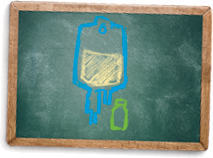This site is intended for U.S. Healthcare Professionals only.


|
Recommended dosage of TEFLARO in pediatric patients 2 months to <18 years is based on age and weight1 |
|||
| Age Range | |||
| 2 months to <2 years | |||
| Dosage and Frequency | Infusion Time | Recommended Duration of Treatment† | |
| 8 mg/kg every 8 hours | 5 to 60 minutes | 5 to 14 days | |
| ≥2 years to <18 years (≤33 kg) | |||
| Dosage and Frequency | Infusion Time | Recommended Duration of Treatment† | |
| 12 mg/kg every 8 hours | 5 to 60 minutes | 5 to 14 days | |
| ≥2 years to <18 years (>33 kg) | |||
| Dosage and Frequency | Infusion Time | Recommended Duration of Treatment† | |
| 400 mg every 8 hours or 600 mg every 12 hours | 5 to 60 minutes | 5 to 14 days | |
For patients with CrCl >50 mL/min/1.73 m2.
Duration of therapy guided by the severity and site of infection and the patient's clinical and bacteriological progress.1
There is insufficient information to recommend a dosage regimen for pediatric patients with CrCl ≤50 mL/min/1.73 m2.‡1
CrCl estimated using the Schwartz equation.
| Recommended dosage of TEFLARO in pediatric patients less than 2 months based on age and weight§1 | |||
| Age Range | |||
| 0§ to <2 months | |||
| Dosage and Frequency | Infusion Time | Recommended Duration of Treatment† | |
| 6 mg/kg every 8 hours | 30 to 60 minutes | 5-14 days | |
Duration of therapy guided by the severity and site of infection and the patient's clinical and bacteriological progress.1
Gestational age 34 weeks and older and postnatal age
12 days and older.


Unreconstituted TEFLARO vials should be stored at room temperature, 25°C (77°F); excursions permitted to 15° to 30°C (59° to 86°F).
Please see individual product label for storage instructions and product expiration date.

CPK=creatine phosphokinase.
| Standard preparation of solutions1 |
| Step 1 |
|
Aseptic technique must be followed in preparing the infusion solution. The contents of a TEFLARO vial should be constituted with 20 mL of one of the following:
|
| Step 2 |
|
The constituted solution must be further diluted in a range between 50 mL* to 250 mL before intravenous infusion into patients. Use the same diluent used for constitution of the powder for this further dilution, unless sterile water for injection was used earlier. If sterile water for injection was used earlier, then appropriate infusion solutions include:
|
Only for the 50 mL infusion bags dilution:
USP=U.S. Pharmacopeial Convention.
For complete instructions on how to prepare TEFLARO for administration, please
see
full Prescribing Information.
Please also see full Prescribing Information.
Please also see full Prescribing Information.